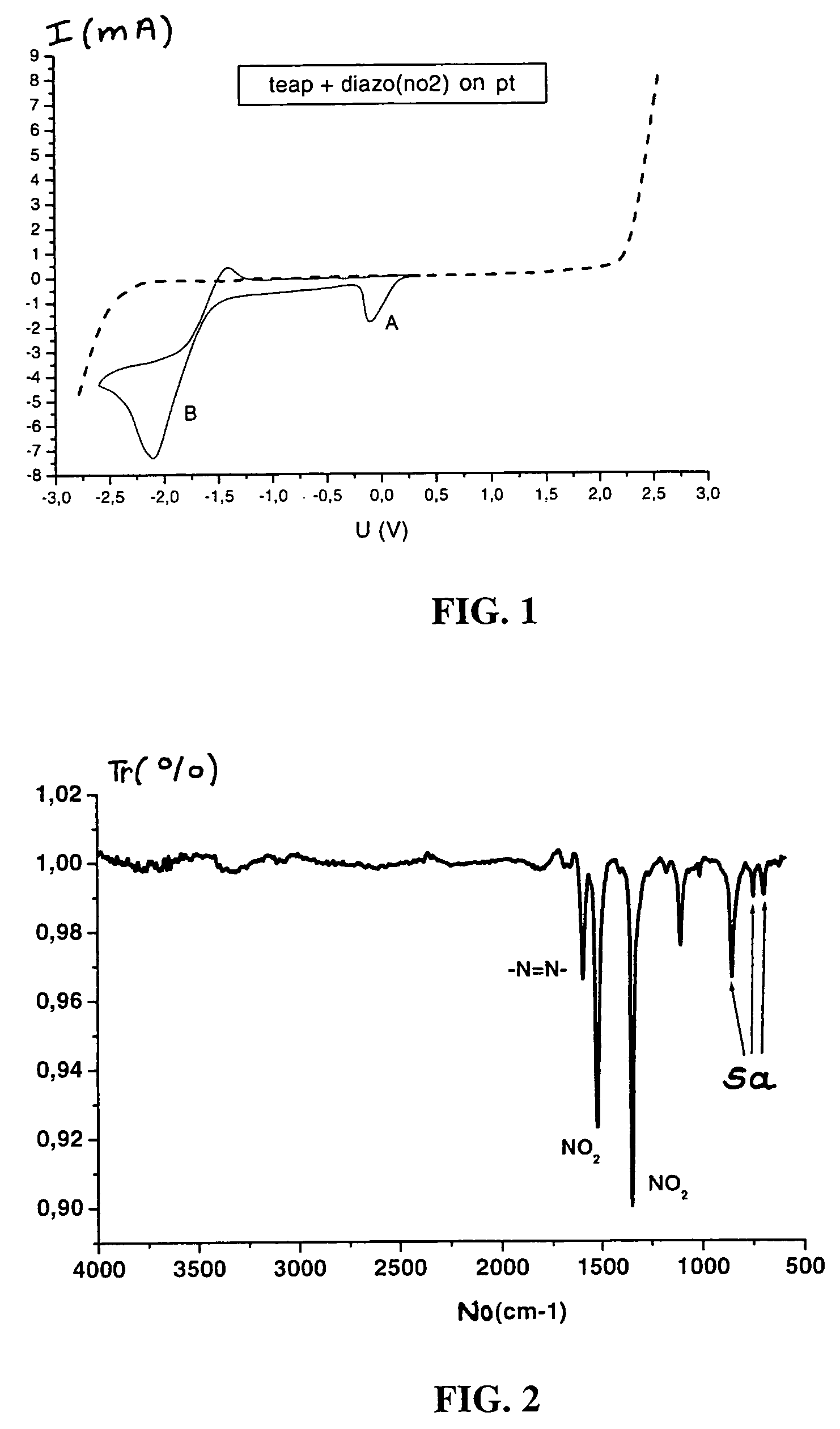Method for grafting and growing a conductive organic film on a surface
a technology of organic film and conductive coating, which is applied in the direction of electrolytic coating, organic conductor, surface reaction electrolytic coating, etc., can solve the problems of not being able to propose a solution for producing conductive organic coating on all types of surfaces, and not being able to meet the technical difficulties of the process
- Summary
- Abstract
- Description
- Claims
- Application Information
AI Technical Summary
Benefits of technology
Problems solved by technology
Method used
Image
Examples
example 1
Control of the Thickness of Applied-Potential Films
[0105]In a first experiment, voltammetric responses of a solution containing 10−4 mol / l of 4-nitrophenyldiazonium tetrafluoroborate in acetonitrile, in the presence of 5×10−2 mol / l of TEAP, on a platinum electrode are measured. The counterelectrode is also a platinum electrode and the reference electrode is an Ag / Ag+ electrode.
[0106]The results of this first experiment are shown in the attached FIG. 1. In this figure the wave “A” is that corresponding to the electro-reduction of the diazonium salt, the wave “B” is due to the reduction of the nitro groups and the dotted curve is that of TEAP alone.
[0107]In a second experiment, a platinum electrode is polarized, under voltammetric conditions, in a solution containing 10−3 mol / l of 4-nitrophenyldiazonium tetrafluoroborate and 5×10−2 mol / l of tetraethylammonium perchlorate (TEAP) in acetonitrile.
[0108]The potential sweeps are applied from +0.3 V / (Ag+ / Ag) to −2.9 V / (Ag+ / Ag), at −200 mV / s...
example 2
Control of the Thickness of Applied-Potential Films
[0113]A platinum electrode is polarized, under voltammetric conditions, in a solution containing 10−3 mol / l of 4-bromobenzyldiazonium tetrafluoroborate and 5×10−2 mol / l of tetraethylammonium perchlorate (TEAP) in acetonitrile.
[0114]The potential sweeps are applied from +0.5 V / (Ag+ / Ag) to −2.5 V / (Ag+ / Ag), at −20 mV / s, as indicated in FIG. 9.
[0115]This FIG. 9 shows voltammograms obtained for the first four potential sweeps, referenced 1, 2, 3 and 4, respectively, of the solution of 4-bromobenzyldiazonium tetrafluoroborate in acetonitrile. The reference 0 indicates the result obtained with the solution containing only the support electrolyte.
[0116]The peak at about −0.25 V / (Ag+ / Ag) is that of the reduction of the diazonium salt, the one at about −2.25 V / (Ag+ / Ag) is due to the reduction of the benzyl groups grafted onto the surface.
[0117]It is observed that the intensity of the latter peak increases as a function of the number of sweeps...
example 3
Control of the Thickness of Applied-Current Films
[0119]A platinum electrode is polarized, under intentiostatic conditions, in a solution containing 10−3 mol / l of 4-bromobenzyldiazonium tetrafluoroborate and 5×10−2 mol / l of tetraethylammonium perchlorate (TEAP) in acetonitrile.
[0120]0.2 μA current pulses with a duration of one second, followed by a rest period of 3 seconds, are applied.
[0121]After recovering and rinsing the platinum electrodes, in water and then in acetone for 5 minutes with ultrasound each time, homogeneous organic films are observed. A thickness of 3 nm after one pulse, 30 nm after 10 pulses and 100 nm after 20 pulses is measured.
PUM
| Property | Measurement | Unit |
|---|---|---|
| thickness | aaaaa | aaaaa |
| thickness | aaaaa | aaaaa |
| electrical contact resistance | aaaaa | aaaaa |
Abstract
Description
Claims
Application Information
 Login to View More
Login to View More - R&D
- Intellectual Property
- Life Sciences
- Materials
- Tech Scout
- Unparalleled Data Quality
- Higher Quality Content
- 60% Fewer Hallucinations
Browse by: Latest US Patents, China's latest patents, Technical Efficacy Thesaurus, Application Domain, Technology Topic, Popular Technical Reports.
© 2025 PatSnap. All rights reserved.Legal|Privacy policy|Modern Slavery Act Transparency Statement|Sitemap|About US| Contact US: help@patsnap.com



